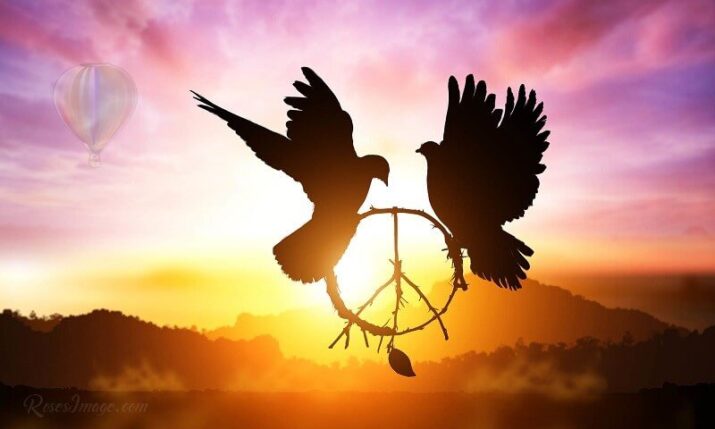From Where Comes the Peace and How We Achieve it?
From Where Comes the Peace and How We Achieve it?
Introduction
Wars are not sacred, as some claim. The attempt to undermine others, erase their existence, or force them to adopt a belief system through coercion and intimidation, all in the name of God, is the pinnacle of deception and evil. History is replete with examples that demonstrate how religious and ethnic intolerance can lead to devastating wars and endless conflicts. This raises the question: Is it possible to achieve peace in our time?

Where Does Peace Come From?
Rapid Changes in the Modern World
Today’s world is changing at an alarming pace, losing both the meaning and essence of its limitations. Much of its humanity and conscience have been sacrificed. Many of us see the results of people’s love for power, wealth, corruption, and lust, leading them away from spiritual and humanitarian values.
The dominance of one person over another results in endless tragedies and suffering. Wars ignite in one place only to extinguish in another, creating a never-ending cycle of violence and destruction. Humanity seems perpetually thirsty for bloodshed and conflict, forgetting that war leads only to ruin and devastation, leaving deep scars on souls and communities.
The Impact of Media
Wars have become a normalized aspect of human life, almost like watching a television series. Violent imagery has taken priority, as social media is flooded with videos and images of violence, including the horrors of ISIS terrorism. The forces of evil today affect children, adults, and families, resulting in hundreds of thousands of dead and injured, alongside millions of refugees and significant material and moral destruction.
These images reflect a painful reality we must confront and work to change. The media plays a crucial role in shaping public opinion, so we must be cautious about how we approach these issues and reinforce positive messages advocating for peace.
The Twenty-First Century: An Opportunity for Change
The Importance of Social Solidarity
The twenty-first century represents a vital crossroads between a confused and ambiguous future or one characterized by solidarity, openness, and liberation. Therefore, we must enhance our collective efforts to open our hearts and clarify our thoughts, extending a helping hand to every person in need.
We must become active agents in our communities to ensure a safe and fruitful life for our children in a future governed by justice and freedom. Social solidarity is not just a slogan; it is an urgent necessity to overcome current challenges, requiring us to work together to build cohesive societies capable of facing difficulties.
The Role of Religions in Achieving Peace
Religions are an essential part of many people’s lives and can play a significant role in promoting peace. When used as a means of tolerance and understanding, religions can help build harmonious communities. Therefore, religious leaders must collaborate to foster interfaith dialogue and deliver messages of peace and tolerance. Religions can serve as a bridge for communication rather than a tool for division, necessitating a commitment from all parties to uphold values of tolerance and mutual respect.
The Importance of Dialogue
Dialogue as a Means of Understanding
Let us begin with dialogue, which is considered the healing remedy for all peoples. We must engage in serious and constructive dialogue to promote tolerance among nations. War does not yield victory; rather, it renders the world inhuman and distorts its humanity, transforming it into a heap of ruins that destroys everything valuable and beneficial. Dialogue is the effective means to reach mutual understanding and is the pathway to building bridges between cultures and religions. Through dialogue, we can transcend differences and build on the commonalities that unite us.
Forms of Effective Dialogue
Dialogue can take many forms, including conferences, seminars, and discussion circles. It is crucial to organize these events regularly, gathering individuals from diverse cultural and religious backgrounds. These events can significantly contribute to enhancing mutual understanding and reducing tensions among communities. Such gatherings should be designed to be inclusive, allowing all parties to express their views and concerns in a safe and respectful environment.
How Can Peace Be Achieved?
Peace as a Comprehensive Value
Peace comes from God, which is why we seek the blessing of peace that cannot be divided or apportioned; it is for everyone. We should adopt a language for the future, learning this new language of dialogue and peace together. Peace is achievable anywhere and at any time, and everyone must work together to realize it, regardless of their backgrounds, ideologies, or religions. With God’s help and our collective efforts, using the language of dialogue, we can transform our world from one plagued by wars and chaos to one characterized by peace and security, for nothing is impossible with God.
The Importance of Education in Promoting Peace
The Role of Education in Building a Culture of Peace
Education plays a pivotal role in fostering a culture of peace. Through education, we can instill values of tolerance and mutual respect in the hearts of new generations. School curricula should include subjects related to peace and human rights, while encouraging extracurricular activities that promote collaboration among students from different backgrounds. Education should not be limited to academic information; it must also encompass the development of social and emotional skills that help individuals navigate challenges peacefully.
Innovative Educational Programs
Innovative educational programs aimed at raising awareness about peace can be developed. Through workshops and interactive activities, children can learn to resolve conflicts peacefully and handle differences positively. These programs can enhance the capacity of future generations to build harmonious communities. Additionally, cultural and artistic activities can foster creativity and collaboration among students.
The Role of Civil Society
Community Initiatives
Civil society plays a crucial role in promoting peace. Non-governmental organizations and local communities can be effective means of communication and fostering dialogue between cultures. These organizations should strive to organize events and activities that bring together individuals from different backgrounds, contributing to mutual understanding and strengthening human connections. Community engagement fosters a sense of belonging and reinforces social ties.
Awareness Campaigns
Awareness campaigns can help disseminate knowledge about the importance of peace and tolerance. By utilizing media and social networks, positive messages can be spread, enhancing the culture of peace among youth and communities. These campaigns require thoughtful strategies to attract public attention and motivate individuals to actively participate in promoting peace.
Promoting Economic Development as a Means to Peace
The Role of Economic Development
Enhancing local economies and providing job opportunities can significantly impact achieving peace. When individuals have opportunities to earn a living and improve their quality of life, they are less likely to engage in conflicts. Governments and organizations must support small businesses and provide vocational training. Economic development is key to improving life quality and reducing social tensions.
Economic Partnerships
Economic partnerships between nations and communities can also promote peace. Through trade cooperation and investment in joint projects, relationships can be strengthened, and tensions can be alleviated. Governments should strive to create an enabling environment for investment and foster innovation through partnerships with the private sector.
Ideas for Building Bridges of Dialogue and Connection Between Peoples
- Organizing Cultural Events: Cultural events can enhance mutual understanding and closeness among people. Through arts, music, and festivals, platforms can be provided for cultural exchange and the strengthening of human bonds.
- Developing Student Exchange Programs: Student exchange programs can foster cultural understanding and tolerance among youth from different countries. Through shared experiences, students can build friendships and understandings that last a lifetime.
- Creating Online Dialogue Platforms: Technology can be used to create online dialogue platforms that bring together individuals from diverse backgrounds. These platforms can facilitate the exchange of ideas and promote constructive discussions on peace issues.
- Encouraging Volunteer Work: Encouraging individuals to participate in volunteer work can help build cohesive communities. By working together towards common goals, human connections can be strengthened, and peace can be promoted.
- Teaching Conflict Resolution Skills: It is essential to teach individuals how to resolve conflicts peacefully. Through workshops and training courses, understanding how to handle disputes in ways that promote peace rather than violence can be enhanced.

Conclusion
Achieving peace is not an easy task, but it is possible through collective efforts and cooperation among people. We must remember that peace comes from the heart and can only be achieved through dialogue and understanding. We must all be active agents in building a world characterized by peace and security.
I hope this article has inspired you and contributed to enhancing your thoughts on how to meet and unite to achieve a world that enjoys peace. How can you come up with new ideas to build bridges of dialogue and connection between people? What methods and approaches can you use to help foster connection and unity toward a world that enjoys peace?
Related Topics
- Star Wars Movie The Force Awakens Has Earned $ Billions
- Benefits of Charity and Assistance to the Needy
- Be Happy Every Day with Doing These 6 Tips All Time
- Home Teeth Whitening with Natural Recipes In Simple Ways
- Lose Belly Fat and Waist Size at Home with Natural Juice
Fastest Effective Ways to Lose Belly Fat for Men & Women







